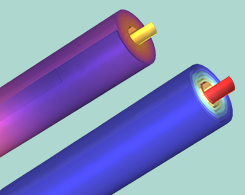Blog Posts Tagged Battery Design Module

Modeling a Solid-State Battery Cell in COMSOL Multiphysics®
Solid-state batteries offer advantages over lithium-ion batteries, making them promising technology for electric vehicles. Simulation can help battery developers investigate design challenges.

Modeling Nonidealities in Electrochemical Impedance Spectroscopy
In this blog post, we explore how to model nonidealities in electrochemical impedance spectroscopy (EIS), often used in the study of electrochemical systems.

The Effects of Varying Solvent Compositions on Lithium-Ion Battery Aging
As lithium-ion batteries age, parasitic reactions can affect the ratio of solvents in the electrolytes. Learn how the consumption of one solvent can impact battery performance.

Simulating Thermal Propagation in a Battery Pack
When batteries overheat, there’s more at stake than just losing the pack. By modeling thermal runaway, you can prevent problems before they arise.

How to Define Load Cycles in Battery Models
Specifying a load profile is critical when modeling a battery system. Explore several approaches for doing so in COMSOL Multiphysics® and the Battery Design Module.

Analyzing Thermal Distribution in a Li-Ion Battery Pack
Deviating from optimal operating temperatures in a Li-ion battery pack can cause performance losses or even failure. Learn how to optimize the power design to control the temperature distribution.

Improving Tabbing Design in Cylindrical Batteries
A major electric vehicle and battery manufacturer announced a new “tabless” design concept for cylindrical lithium-ion batteries. In this blog post, we explore this concept with simulation.

Approaching an Electrochemical Model from Scratch: Lemon Battery
The lemon battery: A high school chemistry experiment, and a great example when learning the general process for how to set up electrochemistry and battery models from scratch.
